 |
| Princess Alice of Teck (later Countess of Althone), 1911. A Lady of the Royal Order of Victoria and Albert and member of the Royal Family Orders of Edward VII, George V, George VI and Elizabeth II |
Many references state that these orders were established by George IV in 1820. This is not quite true. George did establish a personal order, but his successor William IV did not have one and Queen Victoria did not establish one until thirty years into her reign. It was not until 1902 and the succession of Edward VII that the orders as we now understand them (established on the accession of each monarch) begain.
The order is the personal gift of the monarch. The award is not gazetted and no public announcement of the gift is made. There are therefore no lists of members, other than those made by spotting recipients wearing them at formal state events.
George IV
 |
| Victoria wearing the family order of George IV, c.1826 |
Among others, George conferred the order on his sister, Princess Charlotte Augusta, wife of Frederick William, King of Wurtlemberg, and his neices Princess Augusta Caroline, who married the Grand Duke of Mecklenburg-Strelitz, and Princess Victoria of Kent (later Queen Victoria).
The Royal Order of Victoria and Albert
 |
| Queen Victoria's badge had Prince Albert in front |
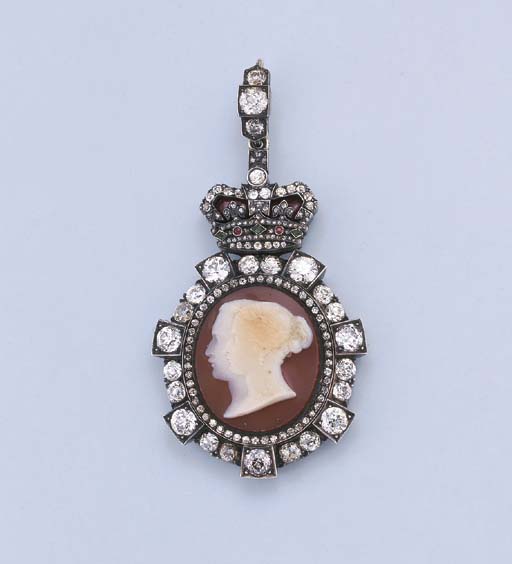 |
| Badge of the 1st Class |
When we got back we went to dear Albert’s room, where I gave Lenchen our presents. Amongst others she got our Order which I have established as a Family Order called the 'Victoria & Albert'.
 |
| Badge of the 3rd Class |
 |
| Badge of the 4th Class |
A list of some members of the order can be found here.
Queen Wilhelmina of the Netherlands, the last surviving member of the first class, died in 1962, and the last surviving member was Princess Alice, Countess of Athlone, who died in 1981. The order is still technically extant, Queen Elizabeth being the sovereign of the order, but no awards have been made since the death of Queen Victoria.
Edward VII and Queen Alexandra
Edward VII instituted a family order before his coronation in 1902.
The badge consisted of a portrait of the king in Field Marshal's uniform with Garter sash and Bath badge with a oak and acorn wreath of diamonds. It was suspended from a ribbon bow of dark blue bordered by narrow stripes of yellow and broader stripes of crimson with narrow black edges.
A picture of the badge awarded the Edward's daughter Princess Victoria can be seen here (with a nifty zoom in facility).
 |
| Queen Alexandra |
- Queen Alexandra
- Queen Maud of Norway
- The Princess of Wales (later Queen Mary)
- Princess Louise, Princess Royal, Duchess of Fife
- Princess Victoria
- Princess Helena
- Princess Louise, Duchess of Argyll
- Princess Beatrice
- Duchess of Albany
- Princess Alice of Albany (Countess of Althone)
- Princess Alexandra of Fife (Duchess of Fife)
- Princess Maud of Fife
Princess Victoria's badge of Queen Alexandra's order can be seen here.
George V
Established in 1911.
 |
| Princess Mary, Countess of Harewood |
Known recipients are:-
- Queen Mary
- The Duchess of York (Queen Elizabeth the Queen Mother)
- Princess Elizabeth of York (Queen Elizabeth II)
- Princess Margaret of York (Countess of Snowdon)
- Princess Alice, Duchess of Gloucester
- Princess Marina. Duchess of Kent
- Princess Mary (Princess Royal, Countess of Harewood)
- Princess Louise (Princess Royal, Duchess of Fife)
- Princess Alexander of Teck (Princess Alice, Countess of Athlone)
- Princess Christian of Schleswig-Holstein
- Princess Louise (Duchess of Argyll)
- Princess Henry of Battenburg
Edward VII
Edward did not establish a royal family order.
George VI
Established 1937.
 |
| Princess Marina, Duchess of Kent |
Known recipients are:-
- Queen Mary
- Queen Elizabeth (the Queen Mother)
- Princess Elizabeth (Queen Elizabeth II)
- Princess Margaret (Countess of Snowdon)
- Princess Alice, Duchess of Gloucester
- Princess Marina. Duchess of Kent
- Princess Mary (Princess Royal, Countess of Harewood)
- Princess Alice (Countess of Athlone)
- Princess Alexandra (Lady Ogilvy)
Elizabeth II
Established 1953.
Known members are:-
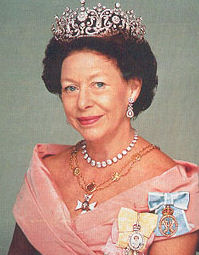 |
| Princess Margaret, Countess of Snowdon |
- Queen Mary
- Queen Elizabeth, the Queen Mother
- Princess Mary, Princess Royal and Countess of Harewood
- Princess Alice, Countess of Athlone
- Princess Alice, Duchess of Gloucester
- Princess Marina, Duchess of Kent
- Princess Margaret, Countess of Snowdon
- Diana, Princess of Wales
- Mary, Duchess of Devonshire
- Princess Anne, Princess Royal
- Camilla, Duchess of Cornwall
- Sophie, Countess of Wessex
- Birgette, Duchess of Gloucester
- Katherine, Duchess of Kent
- Princess Alexandra, Lady Ogilvy
- Fortune, Duchess of Grafton
Mistress of the Robes Badges
 |
| Duchess of Devonshire wearing the badge of the Mistress of the Robes (top) |
Those who have been Mistress of the Robes for the present queen (Mary, Duchess of Devonshire and Fortune, Duchess of Grafton) have been members of the royal family order.
Other ladies-in-waiting have had badges consisting of the jewelled letter 'E' within an oval frame, worn on a pink silk ribbon.
Other Royal Families
The Royal Families of other countries also have personal family orders. For an excellently illustrated discussion of these, see the Royal Order of Splendour page.
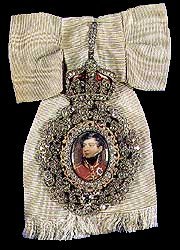
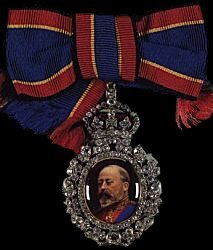
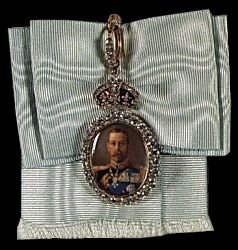
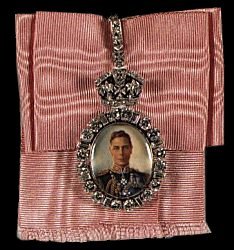
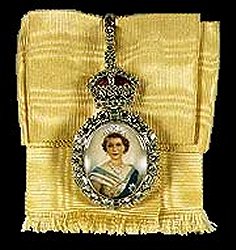
Under Edward VII and Queen Alexandra section the picture you have attributed as "Queen Maud" is rather Queen Alexandra herself, I believe.
ReplyDeleteYes, you're quite right. An embarrassing mistake that I'll correct.
DeleteThanks
Edwin
I saw a portrait in an antique shop of a lady temp 1830s wearing a monogram in diamonds suspended on a blue ribbon. Artist unknown. Sitter u identified. The monogram appears to resemble that of Queen Adelide. I theorize that it is the badge of the Mistress of the Robes of Queen Adelaide, consort of William IV. That would point to the sitter being that of the then Duchess of Leeds, the only lady to help the post during William's reign. How can I confirm this? I need to see a portrait of the duchess, which I have not found on the Internet. I'd like to ascertain that the duchess wore such a badge. The portrait is very fine, because the painter is unknown the price is modest.
ReplyDeleteThat would be Charlotte, wife of the 7th Duke?
DeleteThere's a portrait at https://en.wikipedia.org/wiki/George_Osborne,_6th_Duke_of_Leeds#/media/File:Charlotte_Townshend_(1776-1856),_by_Anne_Mee_nee_Foldsone.jpg
Sorry for the typos. "Sitter unidentified." "That would point to the sitter being the then Duchess of Leeds... The only lady to hold the post.."
ReplyDeleteWhy didn't the Countess of Athlone have George VI's order?
ReplyDeleteShe did.
Delete